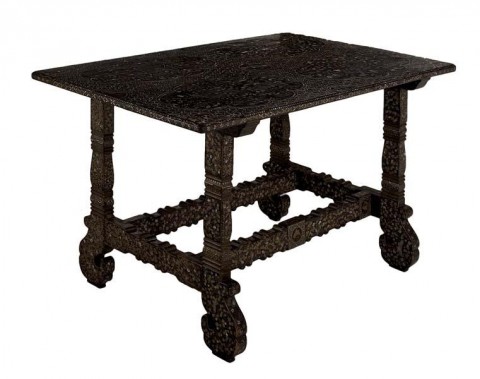Nanban-type table
karta katalogowa kolekcji
Rzemiosło artystyczne
Japan
beginning of 17th century
Wood; black lacquer, mother-of-pearl inlay, gold and silver maki-e
80 x 125 x 82 cm
Wil.968
Nanban, or the “art of the southern barbarians”, denotes sixteenth- and seventeenth-century Japanese works of decorative art, reflecting a discernible impact of European art and tradition. As a rule, they were intended for export to Europe and, more rarely, to India, and their characteristic feature is an unusual combination of Japanese and European qualities.
During the seventeenth century, trade contacts between Europe and Japan were dominated by Portuguese merchants; hence, numerous nanban-type artefacts disclose strong inspiration and references to Portuguese products. The table from the Wilanów collections (early seventeenth century) is a combination of the Iberian and Japanese tradition. It owes its shape to Late Renaissance Portuguese furniture, and its technology and decorative motifs – to the Oriental tradition of lacquer ornaments, which attained its highest level in Japan during the seventeenth and eighteenth century.
The technology of decorating with lacquer is extremely complicated and time-consuming, and calls for workshop mastery. The lacquer used for covering such objects as tables, boxes, coffers, screens and small vessels and containers comes from the treated resin of rhus verniciflua (Toxicodendron vernicifluum) growing in Asia. Decorating consists of numerous, even several score thin layers of resin, coloured usually red and black. Each layer of lacquer placed on the surface of an object must dry or actually harden. This process takes place best in a temperature of about 20° C, and in clean and humid air devoid of dust, which could settle on the surface of the moist lacquer. For this reason, workshops specialising in lacquer decorations were frequently situated on ships or the products were dried in special airing cupboards with moist fabric draped on the walls.
Decorating lacquer products is extremely laborious and calls for enormous precision and skills. Japanese lacquer is, as a rule, decorated in the maki-e technique, i.e. by sprinkling metal particles or dust, also gold and silver, on the surface of the objects. There are numerous variants of this technique, a speciality of Japanese workshops, which achieved exceptional perfection.
The table in the Wilanów collections is entirely covered with lacquer and decorated with mother of pearl incrustations as well as a dusting of gold and other metal particles. The mother of pearl was obtained from the shells of the pteria, i.a. nautilus pompilus. After grating the outer surface, the craftsmen obtained small plates, in which shapes and ornaments used for incrustation were cut out. Mother of pearl panels were glued in the indentations made in earlier placed layers of lacquer. Once all the elements were affixed, the whole composition was again covered with another layer of lacquer, this time colourless, and after it dried it was polished with charcoal.
The table in the Wilanów collections is lavishly decorated, and all the surfaces are adorned with mother of pearl incrustation and sprinkled with silver and gold. The top features, amidst the kikko stylised tortoise shell ornament also likenesses of animals: lions, deer, stags, hares, quails, cockerels, swallows as well as flowers and trees. The table legs are embellished with a thick plant tendril motif and small geometrical ornaments.
The table is one of the most valuable examples of the crafts in the Museum collections, an exceptional work of art representing a supreme level and remains one of only four similar tables preserved in museums in the world. It has been recorded in the Wilanów Museum collections since the mid-nineteenth century and for many years was on display in the Chinese Apartment, created in the early nineteenth century by Stanisław Kostka Potocki, the founder of the museum.
Katarzyna Maleszko
Polecane

European and Oriental laquerware
Oriental lacquer constitutes one of the methods of decorating surfaces made of wood, bamboo, ceramics and papier mâché. Obtained from …

Martin Schnell (1675?–1740?)
One of the greatest masters of European lacquer art — a part of a broader range of art in chinois …

Length of fabric for a kimono
A narrow piece of fabric with the motif of a dragon amidst clouds. According to Japanese tradition, kimonos were made …

















